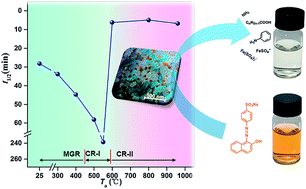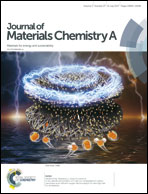Unexpected high performance of Fe-based nanocrystallized ribbons for azo dye decomposition†
Abstract
Different from the reported results, multiphase (Fe73.5Si13.5B9Nb3Cu1)91.5Ni8.5 nanocrystalline ribbons (CR-II) show much better degradation capability in Orange II than their metallic glass (MG) counterparts. CR-II ribbons have superior properties, such as high degradation capability, good durability and facile fabrication. In particular, high degradation efficiency could be expected even under an alkaline environment, while most reported zero-valent metals would only be available for acid or neutral environments. Galvanic cells between the α-Fe nanocrystals and intermetallics contribute to the high degradation capability of CR-II by accelerating the α-Fe nanocrystals to lose electrons, leading to the fracture of the azo bond (–N![[double bond, length as m-dash]](https://www.rsc.org/images/entities/char_e001.gif) N–). Additionally, 3D nanoporous architectures and 3D flowerlike nanostructure sediments formed during the degradation process are also beneficial to the high degradation capability by promoting mass transport. These findings could provide new clues to design new materials with superior degradation capability and low cost for wastewater treatment.
N–). Additionally, 3D nanoporous architectures and 3D flowerlike nanostructure sediments formed during the degradation process are also beneficial to the high degradation capability by promoting mass transport. These findings could provide new clues to design new materials with superior degradation capability and low cost for wastewater treatment.



 Please wait while we load your content...
Please wait while we load your content...